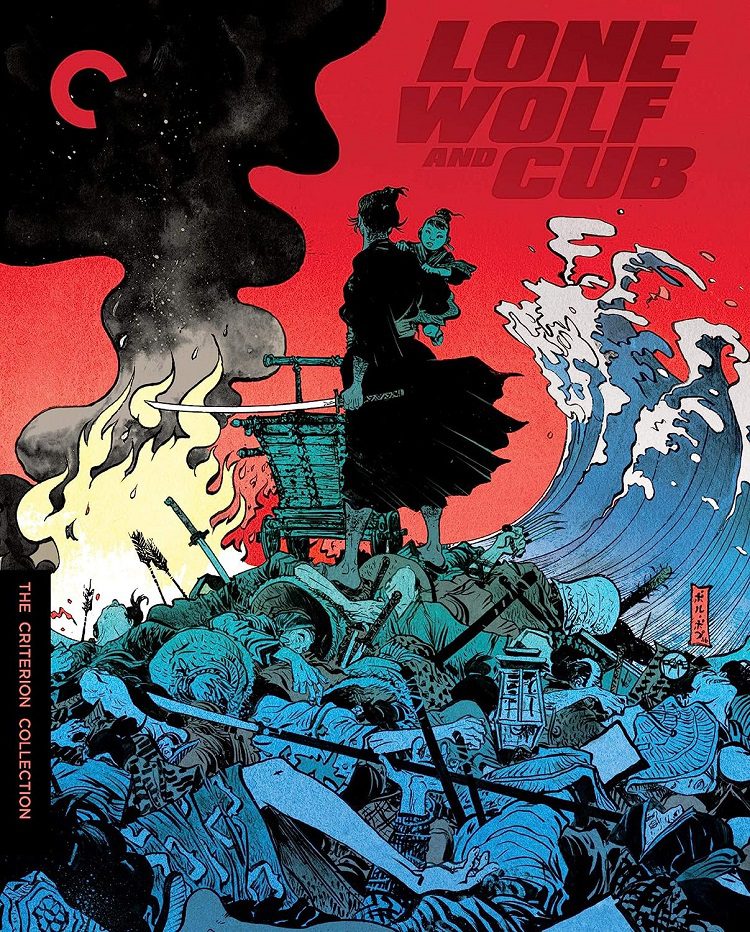
As the shogun executioner, Ogami Itto has a comfortable gig until he falls from grace and endures the death of his beloved wife. Facing almost certain death at the hands of his enemies, the dreaded Yagyu clan, he’s forced to flee and gives his toddler son a choice: die at his hand or join him in a life of hardship on the “demon road”. With no home, no money, and no seeming future, the father becomes an assassin for hire and stays on the move, pushing his son around the countryside in a rickety cart from one misadventure to the next.
Before there were films, Lone Wolf and Cub was a successful manga and a leader in the emergence of gekiga, a dark, mature strain of manga far removed from its comical roots. The serious, violent tone of the manga was carried over to the films, thanks to the screenwriting involvement of its manga creator and writer, Kazuo Koike.
The six films in the series were produced and released within only two years, making their overall high quality all the more impressive. That also solved a logistical problem: keeping the Cub, Daigoro (Akihiro Tomikawa), at a young age. Although the films are definitely all of a whole, they do show some variety as they progress, from the fascination with spurting geysers of blood and rigid, traditional swordplay in the early films to the insane set piece in the much looser final film that finds Ogami battling dozens of swordsmen while sledding downhill with the baby cart.
While the series benefitted from the consistency of Koike’s writing on five of the films, and Kenji Misumi’s directing on four, even the outliers are great fun. Baby Cart in Peril was directed by Buichi Saito and introduces a deadly female assassin who proves to be a formidable foe for Ogami, making for a thrilling and decidedly more lurid outing. Series finale White Heaven in Hell was directed by Yoshiyuki Kuroda, but seems more like a showcase for star Tomisaburo Wakayama’s whims, as the film veers into the supernatural with the arrival of zombie ninjas, as well as the fanciful over-the-top action of the aforementioned snow battle.
As for the technical details, all six films have been digitally restored in 2K from the original 35mm camera negatives, with uncompressed monaural soundtracks, but the quality varies greatly from film to film. I found the last three films to have the best image quality (with White Heaven in Hell possibly the best), while the first and third films were somewhat grainy, and the second film (Baby Cart at the River Styx) was so degraded in comparison that it was practically unwatchable. It isn’t just grainy, it’s like it has a persistent artifacting filter placed over the top of it that seemingly doubles the graininess. All of the films otherwise appear fairly clean, with very little dirt/scratches, and sound is also consistently solid throughout.
The Blu-ray box set has so many bonus features that Criterion devoted an entire disc to them. A large portion of that space is filled with Shogun Assassin, a 1980 English-dubbed mashup of the first two films, not exactly essential viewing for serious fans of the source material. My favorite feature ended up being the one I thought would be the worst: a silent documentary from 1937 about the making of samurai swords. It was fascinating to watch traditional masters craft swords by hand, taking painstaking and incredibly time-consuming efforts to hone their craft to perfection.
Elsewhere, Criterion filmed a new interview with Kazuo Koike where he reminisces about his deceased artist partner on the manga, as well as expresses his affection for the films and his dissatisfaction with a TV series based on his characters. There’s also a French documentary from 2005 about the making of the series, as well as a new interview with a biographer about director Kenji Misumi. My least favorite feature was a recent interview with a martial arts master where he primarily just gripes about the unrealistic swordplay in the films without effectively demonstrating how his techniques are any better.